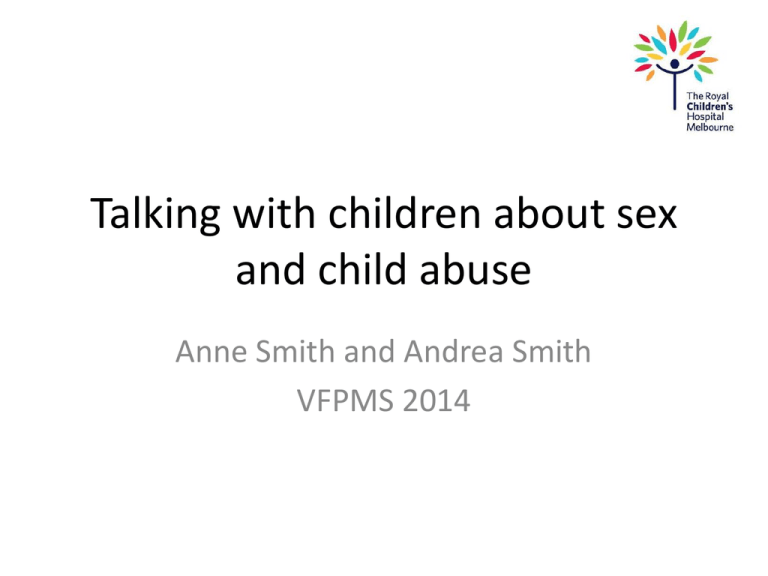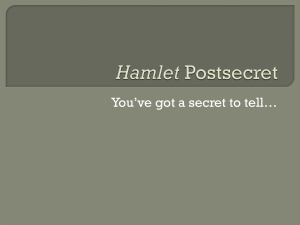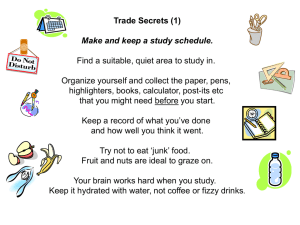Talking about sex and child abuse with children and adolescents
advertisement

Talking with children about sex and child abuse Anne Smith and Andrea Smith VFPMS 2014 This series of slides has been developed to increase the knowledge and confidence of doctors who undertake paediatric forensic medical practice. This advice is provided to assist doctors to talk to their paediatric patients about these difficult topics. Most paediatricians and other doctors who work with children are very skilled at putting children at ease and talking with them about a range of topics. These doctors are able to modify their approach according to children’s mood and developmental levels. Being able to “broach difficult topics” sensitively and carefully with children can be important clinically, forensically and therapeutically. Paediatricians can do it Paediatricians are At ease with children / Use a child-friendly manner Familiar with children’s language & meaning – Strange Language : Child Victims under Cross Examination Brennan & Brennan 1989 (ncjrs) Informed about child development anatomy / use correct terms child behaviour (normal & abnormal) Competent at interviewing multiple sources to gather info Ethical. We desire to do good, not harm Underpinning principles First do no harm (primum non nocere) Be open minded Seek the truth Separate fact from fiction Rely on data not dogma Be a team player / Respect others’ roles Avoid duplication of effort Be honest: Admit when you don’t know Primum non nocere Do • Gauge and respect child’s developmental level, emotional state and willingness (or not) to talk • Preserve innocence and naivety • Respect child’s family and cultural values • Respect parental rights and feelings • Remain mindful of roles of police and child protection – Police interview first (whenever possible) Primum non nocere Don’t • Introduce words beyond the child’s common use & understanding for “private parts” • Corrupt children with your (new) ideas or suggest scenarios/behaviours • Lead with “yes/no questions” • Fail to consider alternative possibilities • Over-interpret words or behaviour with a “confirmatory bias”. Many words and behaviours are non-specific, so treat them as such Be open minded Enter each consultation willing to explore a range of possible outcomes Gather data & information THEN process it Remain open to new, challenging and conflicting ideas throughout Be prepared to change your mind, always Avoid bias (learn about bias, act to minimise it) Seek the truth The truth might not be “a disclosure” – So don’t aim for “disclosure” as the sole outcome A “disclosure” might not be the truth – So seek confirmation / challenge it Ask, “what if....?” • Misinterpreted by an adult (child’s comment / art / behaviour) • Misunderstood / misconstrued by child (no abuse occurred) • Mistake (no abuse intended but contact occurred) • Mischief (e.g. ideas implanted by other) • Malice (e.g. fabricated by child) Separate fact from fiction Understand the literature Including shortcomings of data collection systems and interpretation Child Victims: Who, when, where and why? Who are the abusers and why do they abuse? Juvenile offenders: Are they all just little criminals in the making? What makes children offend? What makes adults sexually offend? Recidivism: Who, when, where and why? Prevention and treatment programs: What works? How strong is the data? What is counselling? Does it work? Rely on data not dogma Where is the data? How solid is it? Where is the dogma? Why did it develop? Be a team player Respect roles and responsibilities Understand the system and the players interactions with each other (not just you) Police interview (VARE) before medical exam Aim to minimise duplication & maximise efficiency Be reliable and dependable Do your job well (quality and safety) Act & Speak up / Advocate for child & system Be honest Don’t overinflate expectations of justice or a particular outcome Don’t make promises you might not keep Consent: ensure it is fully informed If in doubt, don’t (+ ASK/CONSULT) Own all your errors! Speak up when something or someone is wrong “the available information and findings do not discriminate between children who have been sexually assaulted and those who have not” Before you talk with a child Understand developmental pathways Cognition and general behaviour Sexualised behaviour Gather information from others Caregivers Police & child protection Plan how you will proceed in this case Not one size fits all Adapt approach to child Be flexible – child’s emotions, attitude and tiredness will affect the interaction. Document observations. Unwilling child - > abandon the interview. This means STOP Adapt to developmental level Words per sentence = age in years Separating child from parent can help but also can hinder the interview process (Generally younger children prefer their parents present, older children prefer parents NOT to be present) Child’s choice of support person throughout (NB can change mind midway through, and repeatedly) How do I start the conversation? Introduce yourself Explain who you are & what you do Possible conversation starters Why did you come here today? Parents might offer to ‘explain’ the reason Mum said that something happened on the weekend with your cousin Bart and my job is to .... so that we can see if we need to do something about it XXX said that you said something about YYY and it made ZZZ worried. My job is to talk with you and have a look at you to try and understand what might be going on ... (and I will probably tell the police about what we talk about) How do I start taking about sex? Some children will promptly talk about the alleged abuse. Others will need prompts. Don’t interrogate. Before we start, can I ask what words you use for the bits of the body that are usually covered up by bathers/swimsuit/underwear? Parents might need to volunteer words when children are “shy” Is it all right if I write down your words on this picture so I get it right and don’t forget? And what about boys/girls? (other gender) What parts of their bodies are under their bathers? What do you call those bits? What words do you use in your family for those bits? Good touches/Bad touches Not everyone uses this approach It requires an understanding of the interview process and capacity to manage children’s information It is important to record children’s comments verbatim Questions: I want to talk with you about the sorts of touches that people give and get from each other Some touches feel really nice and we feel good about them, some touches feel “not nice” and can make us feel hurt or sad or mixed up or they just don’t seem right somehow. Has anyone given you any good touches? – Any others? Has anyone given you any “not good” or “bad touches”? – Any others? “Private parts” Remember that we talked about your genitals/anus/chest (use child’s terms) before. The bits of the body under your bathers. Some people call them “private parts” Who is allowed to look at them (or use child’s term)? (Reassure that ok for child to look, and Mum/Dad… if sore and child wants them to check, or a doctor if Mum/Dad and child agree and they are with child) Has anyone who is not allowed to, looked at them? “Private parts” Who is allowed to touch them? (Reassure that child can touch, and Mum/Dad if sore and need to apply cream…, doctor…) Has anyone who is not allowed to, touched them? What would you do if someone tried to look at or touch them? (“Stop, I don’t like it”, and tell teacher/parent etc.) Finish with, e.g. “Thank you for telling me this, I think that your body belongs to you and you decide if you want anyone to look at it or touch it” Secrets: Good and Bad Most children your age have secrets of some sort Some secrets are good ones & we feel good about them, some secrets are not good ones, they feel “not nice” and can make us feel worried or sad or mixed up or they just don’t seem right somehow. Do you have any good secrets? Who else knows? Any others? How about the other sort? The “not good” or bad secrets. Do you have any secrets that make you feel bad? Who else knows? Any others? Conversation enhancers And then what? Ah huh, pause.......... Tell me more about that... Can I check that I understood that correctly, did you say .... (reflective listening) When you say “his thing” do you mean his... Pause... “ Conversation stoppers Avoid “did he /she .... ” questions Try to never suggest a behaviour e.g.“Did he put his thing in your ... e.g. “did anything go in your .... “ “did anything come out of his ....” Never suggest a particular individual (by name or relationship) unless and until mentioned by the child Don’t ask Anything about pain unless the child says it first then you can ask about what it felt like and how long it lasted etc. Most child sexual abuse doesn’t physically hurt the genitals. (Most abusers are known to the child and want to come back for more) Don’t ask “Did it hurt?” This could insert a worrying idea into a child’s head If it felt pleasurable then the psychological damage could be worse if you created the idea that it “should” have hurt, not felt nice. Don’t ask Anything about blood, bleeding or discharge unless child introduces the idea Anything about emissions, seminal fluid or other body fluids unless child introduces the idea Refer to the abuser’s behaviour as “naughty” or “bad”; use the term “wrong” Do ask But only if relevant What did that feel like? Genital sensation/ touch How did that make you feel? Emotional feelings And when you did wee after that, how did that feel? Did you notice anything else? Did anything else happen? Did he/she say anything about you telling anyone else about what happened? -> Did he/she what would happen if you told anyone else about what happened? Keep your emotions in check Professionalism at all times No unseemly over-interested questions or harping on about something when child is uncomfortable No gasps and horror/ shock & squirm No tears and sobs (from you) No impatience No visible signs of your disbelief Offer to answer questions Offer to answer any questions the child may have Answer honestly Clarify what will happen next in relation to your roles & the investigation more broadly Offer again “is there anything else that I can do for you today?” Positive comments “Your body is really healthy and strong. Your bottom (+ child’s word for genitals) look exactly right for a girl/boy your age” “No-one will ever know by looking or by touching, what happened to you (+ other words) – the only way anyone will ever know is if you tell them” Explain to older children that usually it is best to tell only people they can really trust because they don’t want everyone at school knowing Quit patronising Respectful courtesy is best • “I could see that you found it really hard to talk about some of the things that happened”. • Thankyou for telling me about ... even when it made you feel really upset to talk about it. • I didn’t want to upset you but I did want to understand what happened so I could work out how best to help you. • “You were so brave” statements can seem hollow, trite and fake so if they aren’t genuine & appropriate statements of fact, don’t say them. Finish with optimism Thankyou for all your help today, you made my job as easy as it could be. Now that we know what happened ... Mum and Dad and all the people you have met this week will do everything we can to make things better for you. The police and I, and everyone else, will get on with our jobs to help you. We want things like (what we talked about) to stop so you can enjoy being a happy girl/boy. I am very happy to see you again if you want to.






